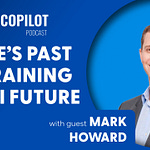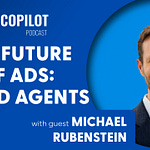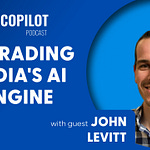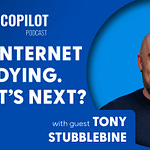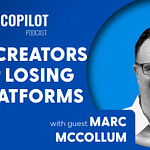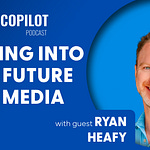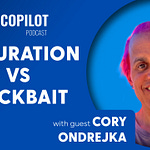For companies building new things and trying to tell their story, there's a lot of talk about "going direct" lately. This is shorthand for a new(-ish) type of PR, where the founder and sometimes other key people simply use social platforms, newsletters and all the other tools of media themselves — eschewing the traditional route of telling their stories through journalists.
The idea has gained traction in the last few years (I moderated a whole discussion about it at Consensus 2024), and whether or not you think it's a smart PR strategy, there's a lesson here for the media itself: bypassing intermediaries is an essential part of audience "ownership" — one of the biggest concerns in a world where AI chatbots now answer user questions without connecting those users to the source that originated the information.
To better understand how publishers and the media can re-assert ownership of their own audiences, I talked to Mike Donoghue for The Media Copilot podcast. Mike is the CEO of Subtext, which transforms text messaging into a broadcast channel — reaching audiences through one of the core apps of the modern smartphone. Publishers use Subtext to create conversations with readers, celebrities use it to connect with fans, and all those interactions can be two-way. All they need to do is hit reply.
Learn how to use AI in journalism, PR, and marketing. Sign up for one of The Media Copilot’s 100% LIVE AI training sessions today!
In a lot of ways, texting seems like the new email, and potentially a way for publishers to create a new surface to reach audiences that they control, shielded from Google, AI, and everything else. I talked to Mike about how Subtext came to be, why texting and SMS might be the last frontier for owning the audience relationship, and the role Subtext can play in a media ecosystem where AI is rapidly becoming the new platform to worry about — and perhaps to master.
It was a surprisingly reassuring conversation, and one that I think will give media owners and operators ideas for how to not just survive, but thrive, in an AI-dominated future. Be sure to listen to the end, where Mike explains why successful media companies might end up looking more like TikTok than The New York Times. As ever, if you enjoyed this conversation, it would be great if you could follow the show on Substack, Apple Podcasts, Spotify, or any other podcast app, really. Also, I’d appreciate it if you’d leave a rating or review — it really does help the show. And if you’re on YouTube, please like the video and subscribe to the channel 🔔
Transcript
Pete Pachal: Mike, welcome to The Media Copilot.
Mike Donoghue: Hey, Pete, thanks so much for having me. Really appreciate it.
So thanks for being on the show, and I really enjoy subtext, so I'm a subscriber to at least a couple of channels that media organizations use. Definitely get stuff there that I don't get in other places. So it's sort of kind of like, can't, I wouldn't say, came out of nowhere, but the whole idea of, like, using text is almost like part of your content distribution system, you know, that's, that's a that's a thing, that's becoming more of a thing. And I'm kind of curious about how this whole thing started. How did this sort of become both a viable way to sort of get content to people, as well as a viable business? So why don't you sort of take me back to the beginning and tell me how subtext came to be?
Yeah, for sure. Well, and glad to hear that. You know, it's a thing that's becoming a thing I can take, sort of the genesis of it. So subtext were at this point, I guess you'd call it's like a five year old startup. And, you know, originally, when we were sort of coming up with, like, the premise for the product, you know, we were taking a look at the media landscape, entertainment landscape, creator space, and we saw the amount of time and money and love and effort and resources that went into building up these huge audiences on social only for a lot of these same organizations or people that kind of come to the realization that they were renting the relationships with their audiences, owning a really meaningful direct line of communication. So we knew that we wanted to facilitate that right, like philosophically and, you know, we thought that there were going to be a variety of ways to do it, obviously, like the email ecosystem five years ago, really crowded, right? The sub stacks of the world, ghost, lead, tiny letter. Everyone is doing a really phenomenal job there. So, you know, we looked at a variety of different mediums. We really kind of fell in love with SMS. I mean, not only for the metrics, obviously, you know, like we send, you know, billions and billions of messages every year, and the open rate on any of that messaging is going to be like 98% CTR is going to be north of 30% so, you know, the metrics are kind of crazy, but I think what we really liked the most about it was the notion that this was like meaningful bilateral communication, right? And, you know, it's genuinely the way that you communicate with your friends and family. So for media companies, for creators, for record labels, you know, we love the idea that we could create like a much more personal touch point, and give audiences the ability to communicate back and forth in a way that wasn't performative, like social media or, you know, would require the degree of sociopathy that you. Would need to, like, reply to an email newsletter and expect a response, right?
Yeah, so, so that's interesting, just so, like, people sort of understand what we're talking about. So if you, if you use sub stacks, if you, if you could subscribe to one of these channels, you can reply to the thread even though it's a group text, but you, it's not like your text goes back to the group, you know, it goes to the sender. That might not be entirely obvious the first time you use it, because I remember the first time I got it. If I reply to this is everyone going to see my response. And it's kind of one of those interesting because it's like one to many. It's kind of broadcast, but it also is a very convenient way to facilitate that back and forth on a one to one basis.
Yeah. I mean, you're absolutely right, right? So, like, when we were originally architecting the tech behind it, we knew certainly that, like, we need to avoid, like, the Reply All Apocrypha, we have, we have clients on the platform that have hundreds of 1000s, if not, you know, a million plus subscribers, right? So the notion that you would have a million people replying all to one another, you know, would have been problematic, as you can assume. But you know, what we've liked about it too is, you know, there's like, there's certainly a subset of people in the world that are comfortable sharing their opinions or replying to content on a platform like x or Instagram or Tiktok, or, you know, even email newsletters. But one of the interesting things that our clients have seen out of the platform is that, you know, look, there's a huge subset of people that wouldn't normally maybe share their opinions or share their insights in a public right and because this is private, more direct, you know, subsequently a safer space for people. There's a lot of insights that our clients glean from that bilateral communication.
Yeah, that's a really important aspect to it. It's sort of, sort of like a siloed medium. Inherently, I want to come back to that, because I think that has a lot of interesting consequences stem from that. But you did mention that you considered other mediums other than text. I'm actually really curious what you kind of looked at as sort of potential ideas as to, you know, create new relationships with audiences.
Yeah. I mean, it's a great question. And I'm like, you know, I'm putting my hat back on from five years ago or whatever it was, but, I mean, email certainly was, like, first and foremost, right? And, you know, I think there's, like, a different way to be able to do email. I mean, it doesn't have to be this sort of like, you know, unilateral communication channel, where it's just like, I hammer you with email newsletters every day. I hope that you open them. And like, certainly, you know, we'll get into, like, the pitfalls with that as it relates to, like, AI and like, what's going to be happening in terms of, like, the distillation of that content and that sort of thing. I mean, the other alternative, right, is that you end up building, like, some modicum of, like a native app, right, where people can communicate in sort of a walled space.
Right. I feel like apps are kind of coming back a little bit. There was a long time there where they were abandoned after there was this flash in the pan in the early days of the iPhone and especially the iPad. And then everyone's like, Oh, it's too much work. You'll get a lot, too much tech debt, blah, blah, blah, and you just do a good website that works well on mobile. And then apps sort of seem like, I don't know that. I might be missing a few cycles in here, but I do feel like, Of late, the idea that you could also do an app is sort of gotten a little more heat in the last few years, and I think this stems from similar idea to what you're doing and newsletters, right? It's like, Were you looking for more surfaces to sort of own the audience relationship? I think that's that's a very much like, just, obviously the trend in media right now, because we went through this whole era, to your point at the beginning, where you kind of, we gave that away media companies right to the to the platforms, and you know, that didn't work out so well for us. So now there's a lot of ways you can do it. Apps are one of them. But again, I don't know to what extent that probably requires a lot of investment. How different that is than it was 10 years ago? Yeah.
Well, look, I mean, it's, it's really interesting to see, sort of the cyclical nature of it, right? I mean, it kind of feels like 2013 again. You know, you have a lot of media companies that are looking at like, hey, how do we create, you know, more interest or more sort of habituated traffic to our homepage, or, you know, how do we invest in an app, which is, you know, considered by many to be, you know, a medium where you do sort of own the relationship with the audience. I mean, the one caveat I would put there, though, is that, you know, in in apps, and you know this is coming to newsletters as well. I mean, the notion that you own that relationship free and clear because somebody has downloaded an app. App is actually a little flawed, interesting, considering that, you know, look, I mean, the Apple ecosystem or the Google ecosystem is going to dictate the availability of that app. It's going to dictate, to a degree, the functionality of that app. It's going to dictate the frequency, or, you know, the efficacy of, like, push notifications that you might use in that app. So, I mean, look, I think you know, if we're looking at opportunities to connect with audiences, free and clear, sort of big tech gatekeepers who have already proven that, you know, they have a vested interest in a lot of instances, in disintermediating, let's say media companies and their audiences. Apps are maybe not, you know, the safe space that people think they are. And I think, you know, I'm sure we'll get into it. But I think the same is true of newsletters too, right? I mean, you Google and Apple. I believe my numbers correct here, control, like 84% of the email client ecosystem, right?
Yeah, that's very good point. So I like where this is going, because we're getting in sort of a nuanced orbits of control, almost where you're right that the app, there's, there's a lot of platform control over how that works, and then you get sort of a layer out. Well, email seems like it is universal, but if you think about what the email apps people use, you're right. It's outlook, it's Gmail, it's Apple's Mail app, and we're already seeing with the glut of newsletters, I keep hearing, we're at peak newsletter. I'm not sure exactly when that happened, but I get the point. We're kind of saturated. I self do a newsletter. It's, there's a lot of them. And so we're starting to see within apps, these client apps, that there's, they're sort of shuffling them off, you know, there's going to be like, you know, filtering the newsletters and putting them in a tab, which makes sense. It's sort of, we're kind of, it was probably inevitable. Text is like, one more layer out, right? And I wouldn't say the platforms have no say where. It certainly seemed like, you know that there's more tech input to that, but it it seems like the logic is similar to newsletters, and that, you know, obviously you understand that, oh, you have this notification you get, you can sort of immediately be a front and center in the user experience on the device they use all the time. But with text that's even more immediate and more personal. It feels like Right, like you can then there's less intermediation, at least at this point, who knows what's going to happen five years, 10 years down the road, as all these platforms evolve, but it seems like the case that everyone was making for newsletters 10 or so years ago is now much more applicable to text.
I think that's absolutely right to be honest with you, right? I mean, you know, there is, look, you know, as much as we might want to deny it, or, you know, it's kind of people say, like, jokingly, like, Okay, we've reached Pete newsletter and that type of thing. I mean, the truth is, like, there is a limit to the amount of content that people can or will consume via email in a given day. And I think, you know, the efficacy of email sort of rises and falls on people's willingness to, like, open it, consume it, and engage with it. So, you know, I mean, email in general is like a really passive experience, right? And, you know, I subscribe to tons of email newsletters, yours included, right? And I think, you know, you do a job and it's super insightful, and I get everything that I need to get from it. But you know, you also have to, like, for a lot of media companies right now that might be resource constrained. You have to look at the amount of time and effort and resources that are poured into creating a daily email newsletter, because it's not easy, right? I mean, it requires a significant amount of work. Compare that to your open rate and your engagement rate and ask yourself, you know what the real return on investment here looks like one and two. What your use of this medium is doing to like further humanize like you as an individual or a brand, if you're a large media company. And you know, the truth is like, I think email newsletters are always going to be table stakes. But, you know, we talk with a lot of executives at, you know, media companies, big and small, and you know, one of the things that we're hearing is like, look, we need to prepare for a post email world. Because, you know, not only generationally, do you know folks in Gen Z like, not spend as much time with their email, but we know that they're spending a tremendous amount of time in any of their messaging apps, right? And I think, you know, short, punchy, engaging content via SMS that gets opened at 98% and requires 10 minutes to create ends up, you know, coming out as a better ROI at the end of the day, right, versus spending the entire data. An email newsletter to get an 18 or 22% open rate on that newsletter.
Totally. It also seems like it's aligning with attention spans, like rather than the newsletter the lengthy ones, which are good, I do lengthy ones, sometimes often actually being able to sort of compress that into texts. You know that that's sort of meeting the audience more where they are as as things evolve. So this, my thing is AI. So we got to talk about AI at some point, but you did mention that the you know, obviously you're talking to publishers all the time and figuring out the strategies that they use to use subtext. I I am curious what you're hearing about, how they are thinking about AI right now. We're obviously at a weird transitional time with respect to AI and media, and we are starting to see all these deals being happening with licensing agreements, presumably as a new sort of frontier to distribute in a way that's sort of fundamentally different than we've seen before, because you're seeing this transformative summarization, which is probably best shown by perplexity right now. But I mean, what are you hearing? What are people saying? Is there a lot of fear about platforms sort of taking over again. It feels like everyone wants to learn the lesson of the scale media era, where we gave everything away to platforms. But it kind of feels like that's playing out again in a way. So how, how like, what are, what are your sort of summarized thoughts based on the conversations that you've had over the past few months about this?
Yeah, I mean, I think you're totally right. You know, look, it's, I think every media company that we talk to recognizes that, like AI is going to be here. It's going to be the future. You can't opt out of the future in this scenario. So the question is, like, how do we play most effectively in this space. And certainly, you know, you've seen certain publishers create, you know, distribution deals or licensing deals with some of the major AI platforms. But I think like the overarching sort of feeling, or like temperature that we get out there in the space is like, there's a lot of consternation, there's a lot of hand wringing when Gemini gets released, and it's very, very easy to see that like, okay, Gemini is going to be distilling content that, you know, we as a media company have spent a lot of time and money to create. They're going to be disintermediating us on search results pages. We used to find like a really meaningful safe haven in our search results pages. We knew how to operate our SEO operations. We knew what referral traffic was going to look like. We knew that, you know, if we wrote the story about what time the Super Bowl starts and we optimized it the right way, we were going to make X amount of dollars, right? I think, like those days are over. I mean, Gemini has sort of put an end to that, right? So the the overarching, sort of, you know, the marching orders, or, you know, the initiatives that we're seeing out of a lot of the media companies is like, Look, I need to sort of give back to, you know, the roots of facilitating audience relationships in like, a sustainable and fully owned way, because you're right, you know, we, the media industry, learned a lot of hard lessons out of the platform era, right? Which is that, you know, we're building our business on somebody else's land here. So when algorithm shift or monetization policies change, or, you know, grant programs are no longer available, this can have a really meaningful impact on the business. So, you know, there's a huge push towards own relationships, improved first party data and the ability to sort of action any of that first party data into, you know, engaging audiences, or reducing subscriber churn, or, you know, any of the other sort of big calls to action for media at this point. So, you know, for some people, it's a wait and see. For, I think, the more innovative or progressive folks, you know, they're pushing a lot of resources that they would have formally had, for, you know, earmarked for SEO, or earmarked for social, into channels that they can they can own, as opposed to rent.
And do you see AI playing a role there? And I'm not talking about the platforms themselves, but like the technology and so, you know, if you know, open AI and Google and others are showing the viability of this chat experience, essentially, this summarization experience on a broad level, is that applicable on a more focused level, like on a. A media sites, platform that could manifest, just simply as a sort of, you know, your chat with the New York Times, with the Wall Street Journal, with whatever it is, and that suddenly becoming a thing. So you have these sort of chat victims all over, in addition to sort of licensing content to the bigger platforms. Right Is that, is there some talk about that? I do see sort of chat sort of being experimented with a little bit here and there, but I don't think it's really progressed much more than that. Do you have any sense of it?
Yeah. I mean, it's really interesting. Oh, by the way, Pete, I'm going to steal chat fiefdoms. I love that.
Chat warlords, perhaps.
Matt, magnanimous warlords, I don't know, but yeah. So, I mean, look, you know, there's going to be a lot of experimentation there. I think, you know, if we look back in 234, years, and, you know, see, sort of, like the chat experience that would have been facilitated by, like, the AI that's out there today, I think we'll laugh at, you know, like, how sort of rudimentary it seemed. And that's, you know, an easy prognostication for me to make, because, I mean, the tech is evolving so quickly, right? I think what it's really bringing to the forefront, though, is this notion that, like, there is sort of a hierarchy in terms of, like, quality of content at all publishers, right? Sure, you know, I think, like, historically, you've always had the, you know, the baseline, sort of foundational content that, like, while not groundbreaking from an editorial standpoint, or, you know, from like, a domain knowledge standpoint, is sort of your bread and butter, right? This is, like, the SEO content. It's what time the Super Bowl starts and that sort of thing, right? Aggregated stuff I'll throw into there too. And what I think you'll see happen in the not too distant future is, like, you know, using AI to accentuate the domain knowledge of a lot of, like, really skilled journalists at these media companies, right? So, you know, I think of, I think of somebody like Sarah Fisher, right? Or, you know what, like, I listen to the podcast, I read the newsletter, I consume the content on site. Obviously, your opinion, Sarah's opinions, the work that's going on in this space. Her access is hugely important to me. Like that's really valuable. I know that I need to be able to read that content. Now, can you know you or Sarah, scale a chat experience to the point where you know you can respond to every single audience member, one on one who maybe has deeper questions or wants to go, you know, a level below the cursory content. No. I mean, you're never going to be able to do that, right? So, you know, I love the notion that in a lot of instances, you know, AI is going to accentuate the importance of domain knowledge and experience and access and quality reporting, while sort of obfuscating the need for a lot of, like, table stakes, aggregate content. And I think AI, just like as a tool, as a tech, will continue to be used to sort of accentuate that knowledge. And, you know, it's going to be really interesting. I mean, it's still, we're not even in, like, the first inning at this point, like we're still singing the national anthem.
That's good. I don't know if I've heard exactly that. I've heard, definitely heard the that the first Indian analogy with the national anthem. Yeah. So you gave me some ideas there about what subset subtext role will could be in sort of this future, and maybe even how AI could play a part in that. So to your point, you said earlier, some people on subtext have really big followings, like they might have 100,000 hundreds of 1000s or a million followers. They could never really reply to everyone who replies back, does, could AI help surface the right things? Maybe it does. Or, I don't know if you're using AI at all on your platform, but it seems to me, even within sort of a sort of a wall domain like that relationship, just having some AI assistance to kind of soar conversations might be helpful. And then trying to, sort of like, in some ways, scale that one to one relationship in some ways. But then again, you know, to your point, the other side of that is like, if it's not you, is it, is it really working? Is that the point? Right? I don't know. And it really kind of depends on the quality of the AI and not other things. But I don't know. How are you thinking about AI, and certainly some with some of your bigger clients, how it might be used?
Yeah, well, so I guess let me start by telling you something that we're never going to do, right? So we are. Never going to use AI to fake a conversation with any of our journalists or any of our artists or any of our media companies. I think you know, one of the unique benefits of our platform is that, by and large, right, you are communicating directly with, you know, the artists or the journalist or the media company in sort of an unfiltered, unfettered way, right? And I think you know that personal betraying, that personal connection for us is, you know, really sort of us abandoning, like, one of the core tenets of the business. But I totally your point. I think your point, the using AI to like, I'll give you a real example, right? So, you know, Miley Cyrus did her album release on our platform, right? And you know, it was communicated to her biggest fans. You know, before it was communicated publicly. And as you might imagine, like hundreds of 1000s of people had, like, really great opinions, and they were very excited, and they were replying back. It's one of the beauties of the medium, right? It's very simple to send a text back. And, you know, our clients see all of those texts like they come into the dashboard. You can consume them. What we love about it and what we think is interesting as it relates to AI, is like, okay, so we got we sent a message to a million people. We got 800,000 responses. How can we synthesize those responses and bubble up sort of actionable insights for our clients? I think that's really interesting. I think similarly, using AI to be able to listen to audiences at scale and then better understand their content preferences. Is really interesting. So like today, for example, if you subscribe to media company A and we ask you a question, Hey, are you interested in politics or tech or business or breaking news, and you reply back, we're going to be listening to the response that you've sent back to that host, and we can automatically, sort of put you into new addressable audiences based on the preferences that you've expressed there, right, which is, again, kind of a Cool, sort of differentiated use of, like, the bilateral communication. But sorry, did I? Does that make sense?
That makes sense. Yeah, exactly. And it's kind of what I was getting at. It's more about the sorting. And certainly, like, I was never thinking like, you should fake a conversation. I think that violates just some basic ethics there might be, I don't know. And maybe this is against the spirit of it, if not the letter of the law, like with disclosure of what you're interacting with, is that maybe a viable thing? Maybe probably not, even though, because, again, it's more like the spirit of the platform, is that one to one. But all of this gets me thinking a bit about just the the platform itself. And this might be a very kind of dumb and obvious observation, but it's like this texting threads that you have ongoing with an audience. I mean, it's content, right? And it's like, it's, it's kind of this walled off content. And again, I'm not, I'm not an expert on how web crawlers work, but it feels like, Oh, this is a way you can create some content and potentially even some IP in a smaller way with your audience, in a way that isn't necessarily, quote, unquote safe, but isn't that is, again, something you kind of own and can repurpose, repackage and do with what you want. And you know, it's one of those things where, whenever I think anyone thinks about creating, like a website today, or any kind of content operation, you think about the open web and what's going on with AI, and it gives you pause, and you're going to really want to have more of these sort of channels that you own, sort of circling around a question there, but it's more like the how, I guess, are your clients thinking about that? Is it something that is more like their repackaging stuff to put into these conversations and and also taking the sort of stuff they're you, they're doing there, the conversations, and turning that into content elsewhere. I suppose it's probably a bit two way,
Yeah, so it's a great question, and, like, a really astute insight too, in terms of, like, the value that the platform throws off, right? So, like, I'll give you an example, like, even from the earliest days when we were operating the platform. So like, you know when covid happened, right? So, you know, we had any number of newsrooms that knew that they needed to cover covid on the local level. They certainly did not have, you know, the people power. Were to be in every city in the United States, but they had massive subscriber bases on our platform. And one of the things that they did was, you know, they sent out basically a, you know, a request for people to take photos of the shelves at their grocery store. Or, you know, the way that they were doing, sort of like, mask mandates in schools or whatever it's going to be, right? And, like, it turned out to be a really powerful, scalable UGC type of with, like, a very low barrier to entry, right? It's like, I don't need to download an app. I can literally take a photo of, you know, the grocery store shelves and send it to you, if you're, you know, Buzzfeed, or USA Today, or, like any of those clients, and that was really powerful, right? And you know, that sort of same spirit continues today, which is that, you know, I'll give you another real life example. So, like, Maggie Rogers is a client of ours, right? And you know, she had some singles that she was going to be releasing, and her fans were thrilled about it. And like, part of what she did was accept voice memos from fans, right? So, like, I record a voice memo, I send it to Maggie. Maggie fielded all of that content and then listened to it and sort of reacted to it on social. And it was like a really fantastic way for fans to literally have their voices heard by the artist, the artists that they so much admired, and, you know, was terrific participatory content for Maggie and the team, right? So, you know, there's a lot of IP that gets created within these conversations that, you know, again, is not broadly available on the open web. And I think, like, one of the really interesting things too, is that, you know, it's, it's, it's not, it's not something that is, you know, difficult to understand. Like, this is sort of a pitch and catch in terms of, like, the question and response type of content. So, you know, we think there's a lot of value there, nice.
So let's get a little forward looking here in terms of, you know, the whole sort of media ecosystem. So we've been talking a lot about finding new surfaces to direct, interact with audiences. Subtext is definitely one of them we've been talking about. Ai, certainly it's here to stay. Certainly it's going to get better. It's going to become more pervasive in some way. Although, you know, there's, there's current, we're currently sort of experienced a bit of an uptick in backlash. So that notwithstanding, what does it look like in five years, you know, or 10 years as the media system evolves, you know, assuming these trends continue and publishers really double down on these direct relationships, but AI also just becomes more pervasive. What's a healthy media ecosystem look like then? And what is substack subtext? Role? I keep almost saying sub stack, I'm sorry.
So the question primarily is like, what does a healthy media, media ecosystem look like in the not too distant future? So, I mean, it's going to be really interesting. I think, you know, there's going to be, there has to be right, like, a really meaningful shift in terms of, like, the way that media companies are communicating with audiences today, I think, you know, again, the notion that, you know, we write a lot of sort of duplicative content, and then we do get out on search, search results pages for referral traffic, and then we subsequently monetize via advertising, based on their referral traffic. I think like that is sort of a notion that is going to fade into the background, right? So, and probably, you know, for the best, I think like that is sort of a healthy evolution in the space in terms of the value that media companies are creating for audiences. So I think what you'll see, my opinion, at least, is, you know, a real sort of diversification and investment in, you know, both the mediums and the individuals that can strike a sustainable balance with, you know, the audiences and creating more participatory experiences for them. So I touched on it before. But like, the notion that, you know, we're hiring journalists that have a really deep domain knowledge that are creating a lot of value, maybe not for the biggest audience possible, but in a really potent way, I think, is going to be interesting because, like, the idea that, like, we're going for sheer quantity and scale of audiences is sort of a dead notion, right? So we need to focus on quality of those relationships, quality of, you know, the mediums that we're using to reach people in and, you know, drawing any of those audience members in. To the experience. Because, like, you know, if you look at the monetization models for media companies, right, like so much of it now is predicated on subscriptions, right, eventually, like, we're going to bounce off the wall in terms of, like, the saturation point for subscriptions for a lot of media organizations. So if you don't have the ability to pour more sand in the top of the bucket, you've got to narrow the aperture through which that sand runs at the bottom of the bucket. So we need to do a better job of engaging audiences. We need to do a better job of proving out the value of our subscriptions and subsequently keeping people around. And I think there's a huge opportunity for media companies to bring their audiences into the fold, right? You know, we touched on the BuzzFeed example, we touched on what somebody like Maggie Rogers would do. And I think generationally, it speaks to, you know, the expectations of a lot of younger audience members that are used to, you know, creating content themselves or, like, further personalizing their experiences. So I realize that's like a roundabout way to answer your question, but hopefully that's helpful.
No, it's very helpful. And I'd like to just end on maybe reversing that and then touching on the very sort of last thing you said about the audiences, which is, what is it? What is a healthy audience? Media diet look like in that same era, right? Obviously, we're talking a lot about the perspective of media companies, journalists and the value of content, but, you know, looking at just habits and you know, we don't really know exactly what is going to be like our smartphones are going to look like in five years, or if we have all doing augmented reality classes, or, you know, we have Tiktok on our watches, or something like that. But how do you sort of think about sort of what an audience, where the audience is going in the not too distant future? Yeah,
I mean, it's a great question. We're going all in on neuralink Pete. I mean, look, I think the media consumption is always going to trail the sort of broader consumption habits for, you know, all media rights. So, you know, that's going to be television streaming, if that's going to be, you know, an uptick in, you know, short form video platforms like Tiktok or something like that. Like, I think media is always going to trail that to a degree, and, you know, with some some difference baked in for, like, generational preferences and that sort of thing. But I think broadly, like you'll see media company and consumers right, try and strike a balance between, you know, their use of the social platforms, their use of email as like a much more passive medium, likely, their use of SMS as as a more active participant medium. And I think, you know, there's going to be sort of growing opportunities. You're already seeing this for media. You know whether or not you're doing like in person events, or, you know whether or not you're doing like Speaker Series, ama, it's like that type of thing. I think that will continue to proliferate as well. And, you know, look, I think for the media companies that have earned sort of the trust and the respect and the habituation of users, you know, the the what's old is new again, right? It's like 2013, home pages, apps, that sort of thing. I think those will, those will continue to do well, right? I think what's likely going to suffer as a result is consumption of like, traditional news media on like certain social platforms, right? Like, you can see the devolution of like, you know, the quality of content on a platform like AX, right? You know, you can, you can see it to a degree on Instagram or Tiktok or that sort of thing. It's like, look, algorithmically, you know, it's just not trustworthy. It's not all that compelling. And you know, look, those are mediums that maybe people don't want to consume news in, right? So, you know, foisting content into those channels. Maybe not the best bet, but it's a long way of saying. I think any of this is going to be sort of a balanced diet, but I think thematically within that diet, you know, we're going to see an increased focus on audience ownership, direct engagement and the facilitation of more participatory experiences for consumers.
Mike, this has been a great conversation. Excited to see where you guys go next.
Thanks so much. Pete. Really appreciate it, and congrats on all this success



